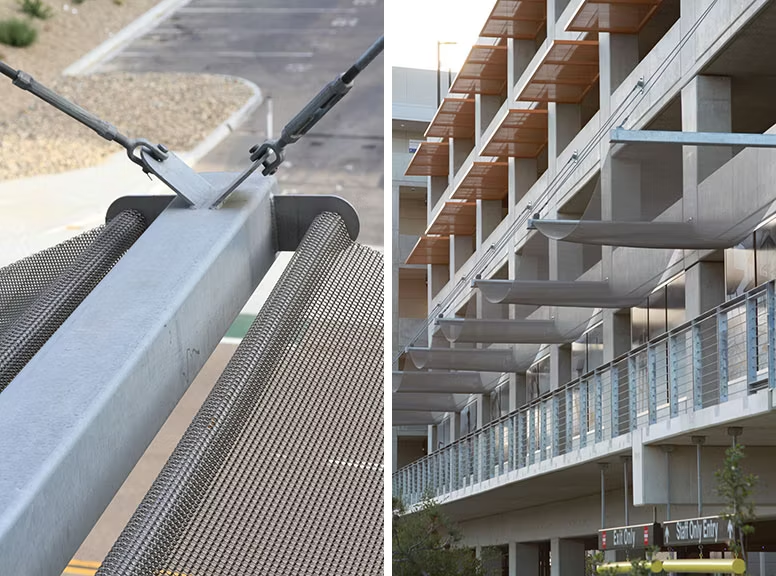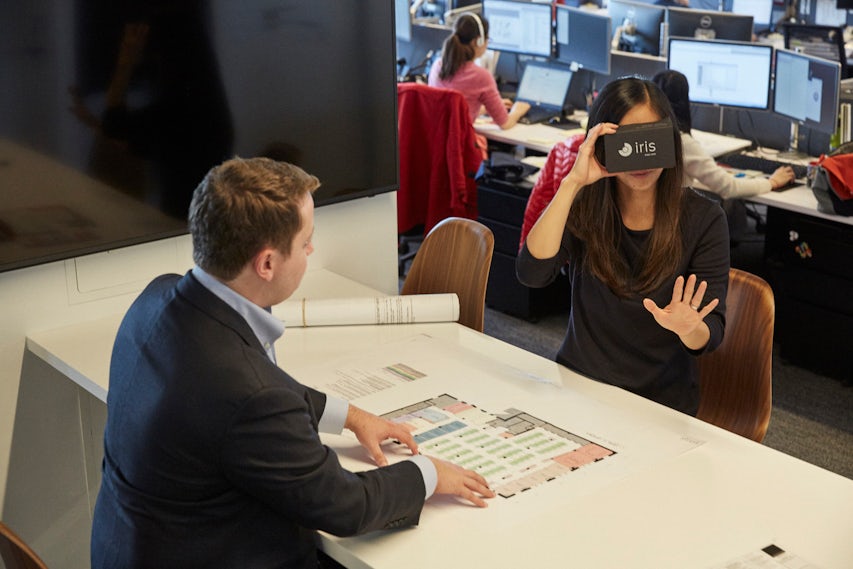Parking facilities are typically massive, nondescript concrete structures, but one firm aimed to imbue one with character — and bring it down to the human scale. The Athena Parking Structure at the University of California, San Diego, Medical Campus “is a bulky thing — a behemoth that’s seven stories tall, and it’s in a very important location,” says Maxine Ward, an associate at San Diego’s Studio E Architects, which teamed up with McCarthy Building Companies and International Parking Design as architect of record to win this commission. “We wanted to break down the scale of the overall massing because the street side steps down to only five stories.”

© Stephen Eckert Photography
© Stephen Whalen Photography
To achieve this, Ward devised a walkway with a series of overhead stainless steel awnings made of Fabricoil® by Cascade Architectural. The coiled wire fabric system, which extends above a third-floor walkway and ultimately creates the series of seven awnings, provides shade and sparkle alike in the sunlight. “It has qualities of lightness and airiness on this heavy concrete structure,” the architect says. “It catches the sunlight and shimmers a little bit.”
Because the structure is designed to serve the needs of patients, visitors and staff at the UCSD Medical Campus, the design team was conscious of the fact that users of the garage might be arriving and leaving under highly stressful circumstances. The architects therefore sought means and methods to make the parking experience as intuitive and pleasant as possible. They also sought a scheme that offered a low-maintenance, cost-effective and highly functional building that recognized the long-term challenges faced by the university.

© Cascade Architectural 2016
The walkway was thus made into an extension of a plaza atop three levels of stairs that lead to elevators for the 1,273-stall parking deck. From the walkway, pedestrians can access automobiles on the third level or stroll 120 feet of the length of the building to an adjacent oncology center. Like the coffee cart, table and chairs on the plaza, the awnings are a reminder that this is a public space, accessible for all. “It creates an overhead ribbon, essentially saying that this is a place for people, not cars, so you can walk by it every day and get a different feeling,” Ward says. “How many people have to take a shortcut through a parking lot? This elevates that experience.”
There were, of course, some concerns in realizing such an installation. First, the architect considered that this product would be exposed to the elements in an exterior application. After consulting the representatives of Cascade Architectural, Ward went with stainless steel as it would resist rust. Then she looked hard at the fabric-like nature of the product and its ability to achieve a consistent curve in the swag of the seven 20-foot-long awnings. “We were concerned at first, but we achieved equal curves above each of the seven bays,” she says.

© Stephen Eckert Photography
© Stephen Whalen Photography
In addition to creating the parking structure, the teams that competed were asked to accommodate two 1.2-million-gallon thermal-energy storage tanks on the same site. Studio E’s winning scheme split the garage open, creating a large palm-filled “canyon” that allowed the tanks to be nested within the heart of the garage. Perforated metal fins sheath portions of the exterior, creating a variegated veil to block direct views of parked cars. Pedestrian circulation — including walks, stairs and glazed elevators — was pulled to the perimeters, bringing life and human activity to the facades.
In essence, the architects took a massive, functional structure, broke it open at the center and introduced natural light there while activating its stairway, plaza and walkway for the people on campus. “We put a lot of effort into getting an active street front,” she says. “There’s the plaza at the stairs, so it’s much more than parking for 1,200-plus cars.”

© Cascade Architectural 2016
Cascade Architectural’s Fabricoil systems, consisting of coiled wire fabric and the engineered attachments for the material’s interior and exterior architectural applications, are used by architects and designers around the world for a wide range of applications. And here at the UCSD Medical Campus, it offered a much-needed flourish. “Everybody agreed we needed it,” Ward says. “The university puts a lot of emphasis on the integrity of design, so we kept it in.”
The only thing missing is a little more shimmer on the stainless steel after the sun goes down. “At night, there are opportunities to illuminate it for a light wash.” That, too, would enhance the human experience outside a darkened parking deck.

© Stephen Eckert Photography
© Stephen Whalen Photography









